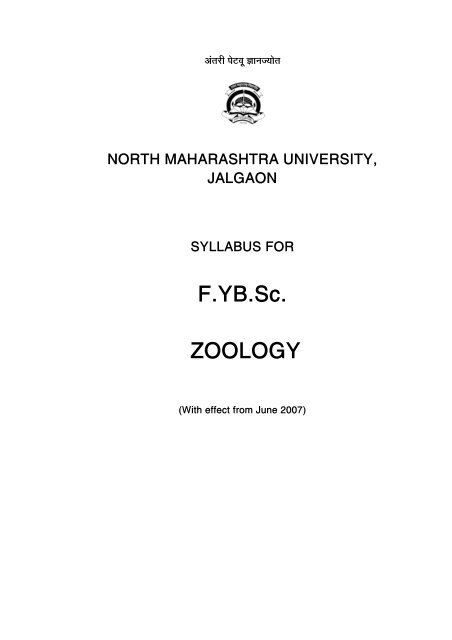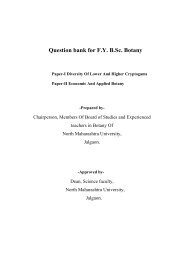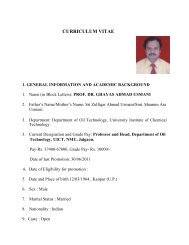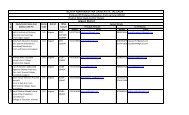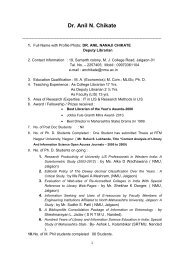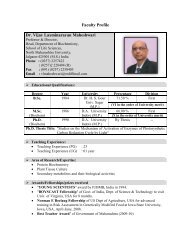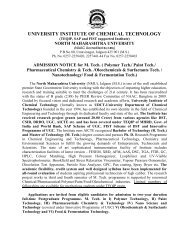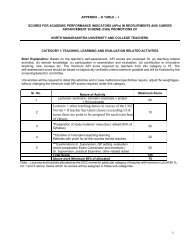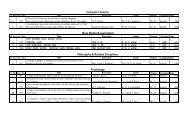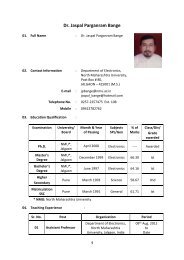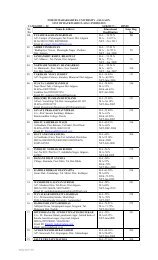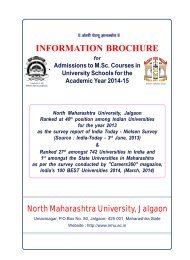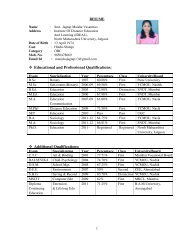FYB Sc - North Maharashtra University
FYB Sc - North Maharashtra University
FYB Sc - North Maharashtra University
Create successful ePaper yourself
Turn your PDF publications into a flip-book with our unique Google optimized e-Paper software.
†ÓŸÖ¸üß ¯Öêü¾Öæ –ÖÖ−Ö•μÖÖêŸÖ<br />
NORTH MAHARASHTRA UNIVERSITY,<br />
JALGAON<br />
SYLLABUS FOR<br />
F.YB.<strong>Sc</strong>.<br />
ZOOLOGY<br />
(With effect from June 2007)
<strong>North</strong> <strong>Maharashtra</strong> <strong>University</strong>, Jalgaon.<br />
Faculty of <strong>Sc</strong>ience<br />
Course Structure in Zoology for F.Y.B.<strong>Sc</strong><br />
With Effect From June 2007<br />
Marks<br />
Paper Course Title Term Periods <strong>University</strong><br />
Exam<br />
Animal Diversity<br />
Section A-Animal<br />
Diversity of Non-<br />
Chordates<br />
Paper-<br />
I<br />
Section B-Animal<br />
Diversity of Chordates<br />
Internal<br />
Assessment<br />
First 45 40 10<br />
Second 45<br />
Total-80<br />
40 10<br />
Total-20<br />
Applied Zoology<br />
Section A-Pest<br />
First 45 40 10<br />
Paper-<br />
II<br />
Management<br />
Section B-Apiculture Second 45<br />
40 10<br />
Paper-<br />
III<br />
Practical Course<br />
Practicals Related to<br />
Paper-I and Paper-II<br />
First<br />
&<br />
Second<br />
90<br />
Total-80<br />
Total-20<br />
80 20<br />
2
F.Y. B. <strong>Sc</strong> (Zoology)<br />
Paper – I Animal Diversity Marks : 80+20<br />
(A – Diversity of Non-Chordates and B – Diversity of<br />
Chordates)<br />
Background of the Course<br />
One of the day’s most pressing environmental issues is conservation of the<br />
biodiversity. Many factors threaten the world’s biological heritage. The challenge is<br />
for nations, Government agencies, Organizations and individuals to protect and<br />
enhance bio-diversity while continuing to meet people’s need for natural resources.<br />
This challenge exists from local to global scales.<br />
Biodiversity is the variety of life on the earth and its myriad of processes. It<br />
includes all life forms, from the unicellular fungi, protozoa and bacteria to complex<br />
multicellular organisms. Practically, biodiversity deals with the collection of<br />
information about species, genera and ecosystems occurring as interacting entities<br />
in any well-defined geographical areas constituting habitats.<br />
Biodiversity can be divided into four levels, genetical, species, ecosystem<br />
and landscape diversity. Most attention is often given to species diversity, the<br />
number of different kinds of organisms found at a particular locale and how it<br />
varies from place to place and even seasonally at the same place.<br />
A diversity of living things provides subtle needs. People enjoy picnicking,<br />
visiting seashores, and a variety of other recreational activities. Our homes, air,<br />
livestock, vegetables, fruits and grains all derive from the product of diverse and<br />
healthy ecosystems. Diverse communities of plants, animals and microorganisms<br />
also provide indispensable ecological services. Insect, help in pollination to plants.<br />
But the value of the biodiversity goes far beyond the aesthetic aspects. We<br />
hardly know a fraction of species on these planets, especially in tropical ecosystem,<br />
despite years of intensive scientific effort. Every year species are lost before we<br />
have a chance to know anything about them. The vast insect faunas contain large<br />
3
numbers of species that are potentially superior crop pollinators, control agents for<br />
weeds and parasites of insect’s pests.<br />
Globally about 1.8 million species have been described and another 11<br />
million species remained to be identified.<br />
Considering the importance of the study <strong>North</strong> <strong>Maharashtra</strong> <strong>University</strong><br />
has introduced the course, animal diversity in our curricula.<br />
Syllabus<br />
A – Diversity of Non-Chordates<br />
Marks : 40 + 10 Total periods : 45<br />
Unit-1- Concept of animal diversity and its significance. 3<br />
Introduction, Animal diversity (Genetic, Species and Ecological<br />
Diversity), Animal diversity at global and country level in brief.<br />
Unit-2- Protozoa 5<br />
2.1.General characters, habit, habitat and distribution.<br />
2.2.Locomotion and osmoregulation.<br />
2.3 Economic importance.<br />
Unit-3- Porifera 5<br />
3.1.General characters, habit, habitat and distribution.<br />
3.2. Coral and coral reefs.<br />
3.3. Economic importance.<br />
Unit-4- Coelenterata 5<br />
4.1.General characters, habit, habitat and distribution.<br />
4.2.Polymorphism in hydrozoa.<br />
4.3 Economic importance.<br />
Unit-5- Helminthes 5<br />
5.1.General characters, habit, habitat and distribution.<br />
5.2.Economic importance.<br />
4
Unit-6- Annelida 5<br />
. 6.1.General characters, habit, habitat and distribution.<br />
6.2.Economic importance.<br />
Unit-7- Arthropoda 7<br />
7.1.General character , habit, habitat and distribution.<br />
7.2.Economic importance of silkworm, prawn and lac insect.<br />
Unit-8- Mollusca 5<br />
8.1.General characters, habit, habitat and distribution.<br />
8.2.Economic importance, Pearl industry, shell industry, ornamental value<br />
of molluscs.<br />
Unit-9- Echinodermata 5<br />
9.1.General characters, habit, habitat and distribution.<br />
9.2. Economic importance.<br />
Books:-<br />
1. Hyman, L.H. : The Invertebrates Vol. I ( McGraw Hill).<br />
2. Hyman, L.H. : The Invertebrates Vol. II ( McGraw Hill).<br />
3. Barnes, R.D. : Invertebrate Zoology ( W.B.Saunders Co.).<br />
4. Jordan, E. L. : Invertebrate Zoology ( S. Chand Co. New Delhi.).<br />
5. Dhami and Dhami : Invertebrate Zoology ( S. Chand & Co. New Delhi).<br />
6. Barrington, E.J.W. : Invertebrate Structure and Function.(E.L.B.S).<br />
7. Metcalfl and Flint, : Useful and Destructive Insects.<br />
8. Shrivastava, : Economic Zoology. ( Commercial Pub.brue,N.Delhi).<br />
Practicals<br />
1) Culture of Paramoecium.<br />
2) Study of locomotion in protozoa.<br />
3) Field study, collection and preservation of animals.<br />
4) Systematic position, habit and habitat of at least one animal of each class of<br />
the phyla.<br />
5) Economic importance of any two animals of each phylum.<br />
6) Identification of mosquito species.<br />
5
F. Y. B. <strong>Sc</strong>. ( Zoology)<br />
Paper I( Animal Diversity)<br />
Syllabus<br />
B - Diversity of Chordates<br />
Marks : 40 + 10 Total periods : 45<br />
Unit-1- Diversity of Chordates 2<br />
1.1.Introduction<br />
1.2. Origin and general characters of chordates.<br />
Unit- 2- Protochordata 6<br />
2.1.General characters, habit, habitat and distribution of Hemichordates,<br />
Urochordates and Cephalochordates.<br />
Unit- 3- Cyclostomata 4<br />
3.1 General characters, habit, habitat and distribution.<br />
3.2.Economic importance.<br />
Unit- 4- Pisces 7<br />
4.1.General characters, habit, habitat and distribution.<br />
4.2.Economic importance<br />
4.3. Migration in fishes<br />
Unit- 5- Amphibia 5<br />
5.1.General characters, habit, habitat and distribution.<br />
5.2.Adaptations for amphibious life<br />
5.3.Amphibians as biological control agents.<br />
Unit- 6- Reptilia 4<br />
6.1. General characters, habit, habitat and distribution.<br />
6.2 Poisonous and non-poisonous snakes, poison apparatus and<br />
importance of snake venom.<br />
Unit- 7- Aves 8<br />
7.1. General characters, habit, habitat and distribution.<br />
7.2.Aerial adaptation and Migration in birds.<br />
7.3.Types of beaks and feet in birds.<br />
Unit- 8- Mammals 5<br />
8.1.General characters, habit, habitat and distribution.<br />
8.2.Adaptive radiations<br />
Unit- 9-Conservation of species<br />
9.1. Threatened and endangered species-causes and importance 4<br />
6
Books:-<br />
1. Jayaraman : Fishes of India.<br />
2. Salim Ali, : Indian Birds.<br />
3. Vishwapremi K.K., : Economic Zoology (Akashdeep Pub.House,New<br />
Delhi).<br />
4. Young, J.Z. : Life of Vertebrate.(E L B S) 1983.Oxford.<br />
5. Dalela, R.C. : A text book of Chordate Zoology, (Jai Prakash Nath<br />
publications, Meerut.).<br />
6. Newman, H.H. : The phylum Chordate, (Satish Book Enterprise, Agra).<br />
7. Jordon, E.L. : Vertebate Zoology, ( S.Chand and Co., New Delhi.).<br />
8. Fred and Theobald, : Economic Zoology.<br />
9. Parker and Haswell Vol. II. A. Z. T. B. S.Publishers and distributers , New<br />
Delhi.<br />
10. Waterman, Allyn et al., Chordate Structure and function, Macmillan and<br />
Company , New York.<br />
Practicals<br />
1) Study of external morphology body forms, fins and scales of the fishes.<br />
2) Systematic position, habit and habitat of one animal from each representative<br />
group of the class.<br />
3) Economic importance of two animals from each class.<br />
4) Study of beaks and feet in birds.<br />
5) Survey of local vertebrates.<br />
6) Report on compulsory visit to a Zoo and Sanctuaries.<br />
F.Y.B<strong>Sc</strong> ( Zoology )<br />
Paper – II Applied Zoology Marks : 80+20<br />
(A-Pest Management and B-Apiculture)<br />
Introduction<br />
The population of the nation is growing tremendously; facing the problem of<br />
the paucity of food and decrease in agricultural land due to increased demand of<br />
dwelling. To overcome this problem and to boost agricultural produce, Govt. of<br />
India had formulated Dr. Swaminathan Committee. Accordingly the<br />
recommendations of the committee were implemented and the nation witnessed the<br />
‘Green Revolution’ and we had surplus production of food, so that we become the<br />
exporters in the world. However, this revolution was temporary, because water,<br />
chemicals and fertilizers were used on a large scale to make this revolution<br />
successful. People began using these fertilizers without taking into consideration<br />
the texture of the soil, availability of water and environmental condition. This has<br />
led to other problems of soil erosion, increased soil salinity, ground water pollution,<br />
7
pesticide residue, pest resistance, nutrient imbalance, emergence of new pests,<br />
diseases and environment degradation. This has resulted in sterility in most of the<br />
lands and there is a danger of transformation of fertile land into barren land . Over<br />
500 million tons of crop production is lost annually due to plant diseases and<br />
insect pest worldwide. Simultaneously, economic condition of farmers is becoming<br />
more stressful and the number of family farms declining.<br />
There is urgent need to develop farming techniques, which are sustainable<br />
from environmental production and socioeconomic point of view. This means to<br />
guarantee sufficient food production without damaging resources, eco-friendly and<br />
cost beneficial pest management is needed.<br />
The <strong>North</strong> <strong>Maharashtra</strong> region is specially known as rural area. The<br />
profession of majority of people is agriculture. Most of the farming in the area<br />
undergoes in the traditional stereotype way. The students coming to the college are<br />
mostly from farmer’s families. The existing courses offered by the college in the<br />
present <strong>University</strong> system have a little emphasis on the agricultural technologies.<br />
In view of growing importance of study of applied Zoology and as per<br />
UGC guideline, <strong>North</strong> <strong>Maharashtra</strong> <strong>University</strong> has framed structure of syllabus of<br />
Zoology and included the applied course, Pest Management and Apiculture at<br />
F.Y.B.<strong>Sc</strong> level.<br />
Objective of the course:<br />
1) To provide simple and understandable applied syllabus<br />
2) To provide direction of higher education towards social utility (benefit)<br />
3) To equip the students with latest technologies in emerging area.<br />
4) To extend the knowledge from laboratory to field<br />
5) To acquaint the student regarding recent technologies in agriculture.<br />
6) To provide the job oriented syllabus to the students.<br />
7) To develop the skills among the students.<br />
8) To achieve the goal of the College /<strong>University</strong>/National Policy.<br />
9) To provide eco-friendly techniques.<br />
8
A) Pest Management: -<br />
Background of the course<br />
Agriculture has faced vast changes, challenges and difficulties in past years.<br />
Indiscriminate use of fertilizers, pesticides and herbicides has polluted our<br />
environment. Varied chemicals, which are applied to soil and plant systems were<br />
not completely degradable and further more appeared to have carcinogenic effects.<br />
Thus increase in the use of inorganic compounds has lead to residual toxicity<br />
problems, which in turn poisoned our food chain. Pesticide residue of DDT and<br />
BHC in lactating women is a typical example of the deleterious effects of pesticides<br />
in agriculture .The continuous use of pesticide created the problem of pest<br />
resurgence and resistance against concerned chemicals.<br />
So there is urgent need to acquaint the farmer regarding the eco-friendly<br />
and cost beneficial technology of pest management like Mechanical, Physical,<br />
Cultural Legislative and Quarantine pest control measures with modern trends as<br />
biological control, Integrated pest management, Genetic control, use of Pheromone<br />
control, Hormonal control, Crop resistance variety, biopesticide and role of<br />
biotechnology in pest control etc.<br />
B) Apiculture: -<br />
Apiculture (Apis- honey bee, culture- to rear) is one of the most important<br />
branch of a applied biology and deals with the rearing of honey bees in order to<br />
obtain honey , wax and also for the increase in crop production by their efficient<br />
service of cross pollination.<br />
Now a day’s beekeeping is an ideal agro-based subsidiary enterprise providing<br />
supplementary / major income to the people in rural areas. Bee keeping in India has<br />
been taken up as a subsidiary source of income by rural people and as a hobby by<br />
newcomers. This subsidiary activity can provide the much needed employment to<br />
the rural people as it employs more than 2.50 lakh people under the purview of<br />
KVIC alone.<br />
In recent years, a number of techniques have been developed for increasing<br />
the productivity of certain agricultural crops through cross-pollination by<br />
honeybees.<br />
Considering the importance of bees in pollination. Himachal Pradesh has taken<br />
the lead in rearing in renting Apis cerana colonies to orchards for the pollination of<br />
apple crops. This programme has created great awareness among orchardists about<br />
the importance of honeybee pollination.<br />
9
Many of our Indian oilseed crops like mustard, sunflowers, safflower, pulses<br />
like tur, beans, forage legumes, vegetable like pumpkins, cucumber, radish, cabbage,<br />
snake gourd, bitter guard (Bhopla), ridge gourd, carrot, cauliflower and onion;<br />
fruits like melons, orange, sweet lime, lemon, pomegranate, guava, apples, and<br />
other crops like cotton, coffee, cardamon require cross pollination via honey bees to<br />
affect fruit or seed setting and also for improving the quality of seed and fruit. The<br />
central bee Research Institute, Pune has taken up experiments on the effect of the<br />
bee pollination in various crops. The result are as follows –mustard 131%,<br />
Sunflower 511%, Niger 112%, Safflower 675%, Linseed 232%, Onion 178%,<br />
Carrot 500%, Radish 700%, Brinjal 125%, fruits 90%, Coffee 83%.<br />
Syllabus<br />
A – Pest Management<br />
Marks: 40 + 10 Total Periods : 45<br />
Unit.1 - Introduction to Pest 4<br />
1.1. Concept and <strong>Sc</strong>ope of Pest<br />
1.2. Classification of pests.<br />
1.2.1. Agricultural pest<br />
1.2.2. Store grain pest<br />
1.2.3. Animal husbandry pest<br />
1.2.4. Public health pest<br />
1.2.5. Structural Pest<br />
Unit.2 - Study of selected insect pest with respect to their marks of<br />
identification, life cycle, nature of damage and control<br />
measures. 8<br />
2.1 Banana – Banana stem borer, Banana thrips<br />
2.2 Cotton-Red cotton bug, Pink boll worm<br />
2.3 Sugarcane-Sugarcane leafhopper- Pyrilla<br />
2.4 Mango-Mango stem borer<br />
2.5 Jowar- Jowar stem borer<br />
2.6.Brinjal-Brinjal shoot & fruit borer<br />
2.7 Wood-White ants –termite<br />
2.8 Store grain –Sitophilus, Callosobruchus<br />
Unit.3 - Primary Control Measures 4<br />
3.1. Mechanical measures<br />
3.2. Physical measures<br />
3.3. Cultural measures<br />
3.4. Legislative measures<br />
3.5. Quarantine measures<br />
10
Unit.4 - Chemical Control 4<br />
4.1. Classification of insecticides-based on the modes of their entry<br />
with one example each.<br />
4.1.1.Stomach poisons<br />
4.1.2.Contact poisons<br />
4.1.3.Systematic poison<br />
4.1.4.Fumigants<br />
4.2. Insecticidal formulations and dilutions<br />
4.3. Drawback of Chemical Control<br />
Unit .5 - Biological Control of Insect Pest 5<br />
5.1. Introduction, definition<br />
5.2. Biological agents - Desired qualities of biological agents.<br />
5.3. Autocidal control.<br />
5.3.1. The male sterile techniques<br />
5.3.2. The genetic technique<br />
5.3.3. Pheromonal technique<br />
5.3.4. Hormonal control<br />
5.4. Advantages of biological control.<br />
5.5.Drawbacks of biological control<br />
5.6.Biological control management<br />
Unit.6 - Integrated pest management 8<br />
6.1. Introduction<br />
6.2. Principle<br />
6.3. Integrated tactics<br />
6.3.1. Plant resistance<br />
6.3.2. Cultural method<br />
6.3.3. Biological control<br />
6.3.4. Pesticides<br />
6.3.5. Other methods<br />
6.4. Pest management strategies<br />
6.5. Integrated pest management modeling.<br />
Unit.7 – Pesticide-appliances 4<br />
7.1.Sprayers & Dusters<br />
7.2.Collecting, mounting and preservation of insect pests.<br />
7.3.Pesticide safety<br />
Unit.8 - Preparation and method of application of herbal pesticides 4<br />
8.1. Neem extracts- leaves /seeds/bark<br />
8.2. Dashparni ark<br />
8.3. Tobacco extracts<br />
8.4. Camphor<br />
Unit.9 - Non –Insect Pest : Rat 4<br />
9.1. Introduction, habit and habitat<br />
9.2. Breeding potential, Nature of damage<br />
9.3. Control measures.<br />
11
Books:-<br />
1.Crop Pests and How to Fight Them-Director of Publicity,<br />
Government of <strong>Maharashtra</strong>.<br />
2. The Year book of agriculture –U.S. Department of Agriculture<br />
3. Pruthi, H.S. : Textbook of Agricultural Entomology.<br />
4. Little and Little : General and Applied Entomology.<br />
5. Fadt, : Fundamental of Entomology.<br />
7. Pradhan, : Insect Pest of Crops.<br />
8. Tembhare T. B. : TB of Modern Entomology.<br />
9. Gupta, : Essentials of biotechnology.<br />
10.Shrivastava : Applied Entomology Vol. I and II.<br />
11.Pedigo- Entomology and Pest management .<br />
Practicals<br />
1. Preparation of aqueous Neem extracts from leaves /seeds /bark<br />
2. To study the effect of Neem extract on mosquito /any pest<br />
3. Study of rearing of Guppy and demonstration of feeding on mosquito<br />
larvae.<br />
4. Study of the following pests with emphasis on the appropriate stages<br />
causing damage- Banana stem borer, Banana thrips Red cotton bug,<br />
Pink boll worm Sugarcane leafhopper- Pyrilla, Mango stem borer,<br />
Jowar stem borer, Brinjal shoot & fruit borer, Termite, Sitophilus,<br />
Callosobruchus etc<br />
5. Preparation of different types of poison baits for the control of rat.<br />
6. Collection, preservation and submission of any five pests.<br />
7. Compulsory field visit to observe different pest in their natural habitat.<br />
8. Study of modern pesticide appliances-sprayers and dusters.<br />
F. Y. B. <strong>Sc</strong> ( Zoology)<br />
Paper II-Applied Zoology<br />
Marks-40+10<br />
B) APICULTURE<br />
Total Periods-45<br />
Unit-1.Introduction of Modern bee keeping 3<br />
1.1. Importance of beekeeping<br />
1.2. <strong>Sc</strong>ope of beekeeping<br />
Unit –2.Taxonomy, Bee Species and their Distribution 3<br />
2.1. Taxonomic position<br />
2.2 .Bee species<br />
2.2.1. Apis dorsata<br />
2.2.2. Apis florea<br />
2.2.3. Apis cerena indica<br />
2.2.4. Apis mellifera<br />
12
Unit.3. Morphology of Honey bee (Apis cerena indica) 7<br />
3.1. Study of mouth parts, legs, digestive system and sting apparatus of<br />
honeybee.<br />
3.2. Cast differentiation, Colony organization and Polymorphism<br />
3.3. Division of labor in honeybee<br />
3.4. Life cycle of honeybee and nuptial flight<br />
Unit.4.Bee behavior and Communication 3<br />
4.1. Absconding<br />
4.2. Round, Circular, DVAV, Cleaning, Masses and Alarm dance.<br />
Unit.5. Beehive, Swarm and Colony of bees and <strong>Sc</strong>ientific bee keeping 8<br />
5.1. Bee Hive<br />
5.2. Swarm<br />
5.3. Methods of Swarm capturing<br />
5.3.1. Capturing a Swarm from a tree branch<br />
5.3.2. Capturing a Swarm from Ground<br />
5.4.Hiving of Colony<br />
5.5. Handling the Colony<br />
5.6. Application of honeybee pheromones in beekeeping<br />
5.7 Controlling swarming<br />
5.8. Hiving by dividing an established colony.<br />
5.9. Establishment, Seasonal Management of apiary and inspection of bee<br />
colonies.<br />
Unit-6. Beekeeping equipments – 3<br />
6.1 Equipments for improving efficiency of honeybees<br />
6.2 Equipments for improving efficiency of bees keepers<br />
6.3. Equipments for improving hygienic conditions<br />
Unit-.7. Apiculture in Agriculture 8<br />
7.1. Bee plants and floral calendar- Importance and qualities of good bee<br />
flora.<br />
7.2. Foraging behavior of bee,<br />
7.2.1. Foraging speed and foraging rate.<br />
7.2.2. Foraging distance and areas.<br />
7.2.3. Pollination efficiency.<br />
7.3. Pollination<br />
7.4. Need of bee pollination<br />
7.5. Management of honeybees for pollination.<br />
7.5.1. Foraging strength of the colonies.<br />
7.5.2. Requirement of honeybee colonies.<br />
7.5.3. Foraging efficiencies of the colonies and their distribution<br />
in the crop.<br />
7.5.4. Moving and conditioning of the colonies.<br />
7.5.5. Increasing attractiveness of the crop.<br />
7.5.6. Increasing the proportion of the pollen gatherers.<br />
7.5.7. Breeding of honeybees for pollinations.<br />
7.5.8. Recent trends in pollination with bees and future thrusts.<br />
7.5.9. Pollination in green house cages.<br />
13
7.6. Bees as input to agriculture<br />
7.7. Improvement of bee forage.<br />
7.8. Bee keeping and its prospectus for agriculture, horticulture, and<br />
forest development.<br />
7.9. Migratory beekeeping<br />
Unit-8.Honeybee products 4<br />
8.1. Honey- Its constituents, methods of collection and uses.<br />
8.2. Importance of other bee products to mankind<br />
a) Pollen –Method of collection, constituents, uses.<br />
b) Royal jelly- Method of collection, constituents, uses.<br />
c) Propolis - Method of collection, constituents, uses.<br />
d) Bee wax- Method of collection, constituents, uses.<br />
e) Bee venom- Method of collection, constituents, uses.<br />
Unit-9.Problems of beekeeping industries. 4<br />
9.1. Natural Climate Condition.<br />
9.2. Natural Enemies and Pest.<br />
9.3. Human Activities.<br />
9.3.1. Bush Burning.<br />
9.3.2. Pesticide bee Poisoing.<br />
9.4.Bee diseases.<br />
9.4.1. Brood diseases.<br />
9.4.2. Adult bee diseases.<br />
9.5. Apiary and Hive Hygiene<br />
Unit-10. Courses and Institutes for the advance studies in Apiculture 2<br />
Books:-<br />
1) Introduction to disease of bee –Bailey ,L<br />
2) World of honeybee –Butter C. G.<br />
3) Beekeeping in India –Sardar Sing (ICAR)<br />
4) The Principle of Insect Physiology-Wigglesworth, V.S.<br />
Practicals<br />
1) Study of external morphology of honeybee<br />
2) Study of Indian species of honeybee<br />
3) Study of life cycle of honeybee<br />
4) Study of architecture of honey comb<br />
5) Study of diseases, pests, parasites and predators of the honeybee<br />
6) Study of bee keeping equipments and their uses<br />
7) Study of artificial bee breeding technique<br />
8) Visit to an apiary to study bee-crop relationship and management practices of<br />
honeybees for pollination<br />
9) Chemical analysis of honey- test for pure honey<br />
10) Maintenance of honeybee colony (Compulsory Rearing of live colony) in<br />
every college.<br />
11).Mounting of Antenna cleaner, pollen basket, sting apparatus and<br />
mouthparts.<br />
14


